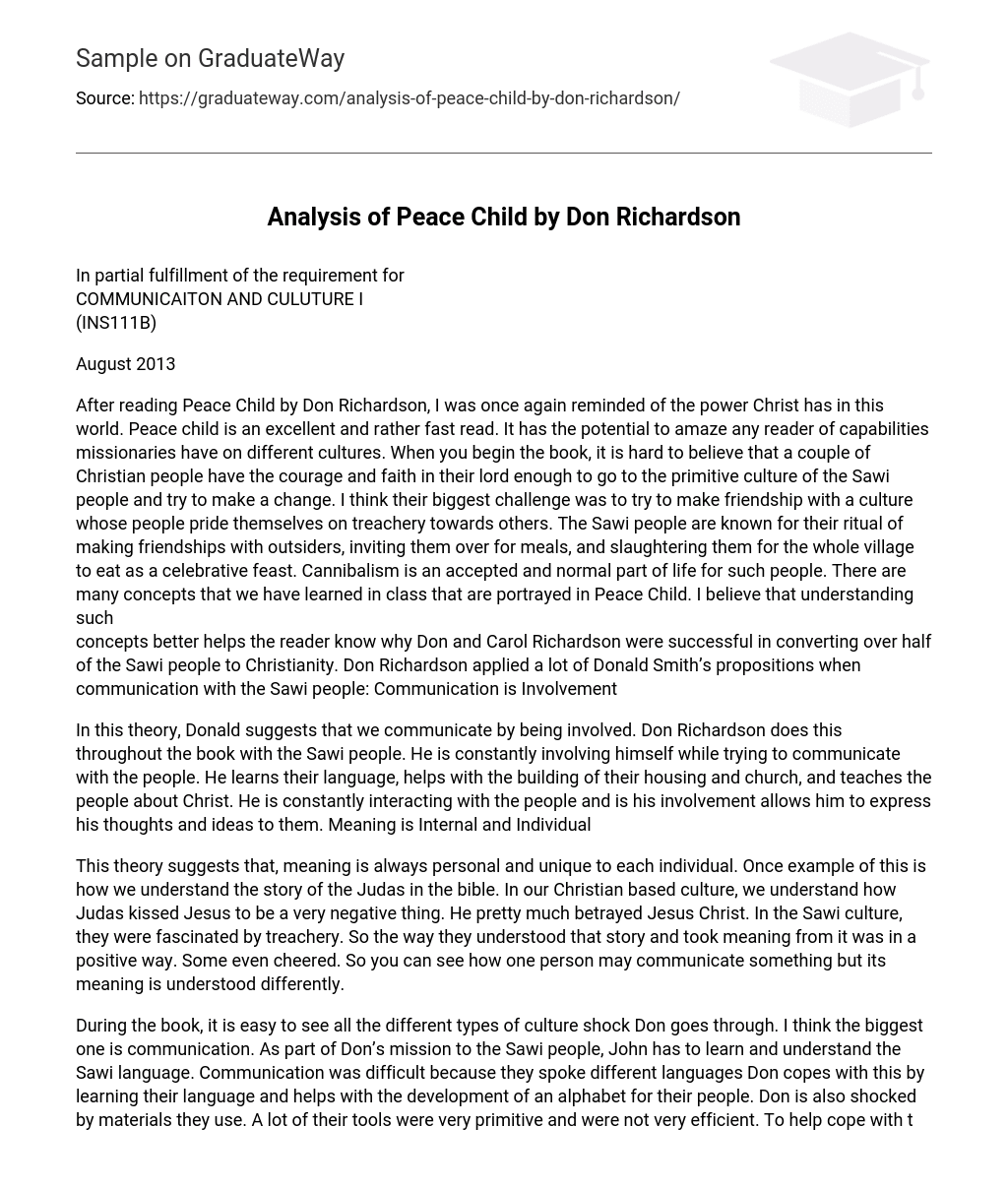After reading Peace Child by Don Richardson, I was once again reminded of the power Christ has in this world. Peace child is an excellent and rather fast read. It has the potential to amaze any reader of capabilities missionaries have on different cultures. When you begin the book, it is hard to believe that a couple of Christian people have the courage and faith in their lord enough to go to the primitive culture of the Sawi people and try to make a change.
I think their biggest challenge was to try to make friendship with a culture whose people pride themselves on treachery towards others. The Sawi people are known for their ritual of making friendships with outsiders, inviting them over for meals, and slaughtering them for the whole village to eat as a celebrative feast. Cannibalism is an accepted and normal part of life for such people. There are many concepts that we have learned in class that are portrayed in Peace Child. I believe that understanding such
concepts better helps the reader know why Don and Carol Richardson were successful in converting over half of the Sawi people to Christianity. Don Richardson applied a lot of Donald Smith’s propositions when communication with the Sawi people: Communication is Involvement.
In this theory, Donald suggests that we communicate by being involved. Don Richardson does this throughout the book with the Sawi people. He is constantly involving himself while trying to communicate with the people. He learns their language, helps with the building of their housing and church, and teaches the people about Christ. He is constantly interacting with the people and is his involvement allows him to express his thoughts and ideas to them.
This theory suggests that, meaning is always personal and unique to each individual. Once example of this is how we understand the story of the Judas in the bible. In our Christian based culture, we understand how Judas kissed Jesus to be a very negative thing. He pretty much betrayed Jesus Christ. In the Sawi culture, they were fascinated by treachery. So the way they understood that story and took meaning from it was in a positive way. Some even cheered. So you can see how one person may communicate something but its meaning is understood differently.
During the book, it is easy to see all the different types of culture shock Don goes through. I think the biggest one is communication. As part of Don’s mission to the Sawi people, John has to learn and understand the Sawi language. Communication was difficult because they spoke different languages Don copes with this by learning their language and helps with the development of an alphabet for their people. Don is also shocked by materials they use. A lot of their tools were very primitive and were not very efficient. To help cope with the shock, he lets them use his tools made from steel that were much more efficient. They even built him a home in return for the use of his steel tools.
The Sawi people began with a non-Christian like belief systems. They still believed in legends, obscene rituals/customs, and spirits. Their belief system included honoring treachery. They believed on befriending someone, fattening them up, and killing them. Those who did so were considered heroes. They were often fighting and going to battle for various reasons.
Don Richardson was able to use the onion model of layers of culture in bringing change to the Sawi people. Behavior Level: Don studied the patterns of behavior in the culture. He learned them and became accustomed to them. He used their behavior patterns to analyze the people and learn to better communicate with them by becoming involved. Social Authority: Don emphasized on befriending key members of the Sawi society such as the elders, chiefs, and warriors. Through interaction with those key members, he was able to communicate with them. They learned to interact and he chose important members to go back and communicate Christian concepts to the others. He was also able to explain to them they needed to make peace with the opposing tribes or they were going to leave.
Experience: Due to Don’s personal involvement in Christianity, Don was able to pass along the views and ways of the new testament to the others. He was able to use some redemptive analogies to and things that the Sawi people had experienced as a way to introduce Christ. Core: After spending a lot of time with the Sawi people, Don was able to change a lot of worldviews of the Sawi. After converting to Christianity, one is required to look at the world in a different light. Their world views and the way they judge others will definitely change. A lot of their ways in the past will no longer exist.
I think the most prominent position of Niebur that seems to appear in Don’s actions, choices, and behavior is Christ as a Transformer of Culture. Its proponents try to convert the values and goals of secular culture into the service of the kingdom of God. We must work to make culture Christian. Culture is corrupt yet redeemable.
In the book, Don explains to the people why they need Christ and what he has done for them. He works very hard to try to change the primitive Sawi ways. He also teaches them that some of their cultural activities such as murder and treachery are corrupt. They are still redeemable and can be forgiven through Christ. He is able to transform them successfully and eventually creates a bible in their language, builds a Church for worship, and Converts over 50% of the Sawi.





